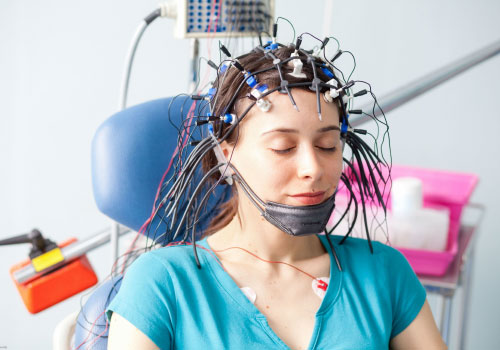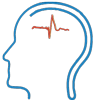EEG (Electroencephalogram) Test
EEG Test
A EEG (Electroencephalogram) test is to monitor and analyse electrical pulses in the brain. The brain cells communicate with one another through electrical activity. An EEG will identify any issues related to your brain activity.

How does EEG record brain activity?
Using electrodes, this technique captures brain wave patterns. These electrodes are wire-strapped to the scalp. The electrodes then record the electrical impulses and transmit signals to the computer at the same time. The findings will then be recorded and displayed by the computer.
These records are comparable to waves. It has significant peaks depending on how active your brain is. Your doctor is in charge of examining these lines. This data may be used to identify any indications of abnormality. If there are any, it may be an indication of some brain disorder.
What are the abnormalities detected by EEG?
Digital EEGs may aid in the detection of brain abnormalities. These anomalies may be linked to brain problems, so it is critical to be aware of them early on. The digital EEG technique may identify the following abnormalities:
Epilepsy
Epilepsy is a neurological disease that may result in repeated seizures. Seizures are thought to be caused by a surge of electrical activity in the brain. These seizures may impact the whole brain or just specific portions of it. Mild seizures, as opposed to more severe ones, may be difficult to detect. Seizures that are more severe are likely to produce muscular spasms. Depending on the intensity, these seizures may last several minutes.
Tumors of the Brain
Brain tumours are a cluster of abnormal brain cells. The development of these tumours in your skull may create plenty of issues, particularly if the tumours are malignant. If left untreated, brain tumours may create increased pressure within the skull, resulting in irreversible brain damage.
A Head Injury
Head injuries may range from minor bruising to severe damage. Concussions, scalp wounds, and fractures are the most frequent kinds of head injuries. Depending on the severity of the condition, different therapies may be suggested. It is important to have your doctor evaluate the injury as soon as possible in order to identify the severity and expedite treatment.
Coma
When a part of the brain is damaged, a person may go into a coma. The damage may be either short or permanent. This results in a protracted condition of unconsciousness and inability to respond. Injuries, strokes, malignancies, alcohol and drug addiction may all result in comas. When a patient is in a coma, digital EEGs may detect brain activity.
What Is the Purpose of EEG?
EEG is mostly used to diagnose seizure disorders. It is also used to detect coma, encephalopathies, encephalitis, sleep problems, anaesthetic depth, and brain death. It is also used to distinguish between seizures and pseudoseizures. EEG is especially helpful in the ICU to rule out potentially fatal conditions such as status epilepticus.
How Should You Prepare for a EEG?
The night before, wash your hair. Apply no oil, gel, or hairspray to the hair.
Are there any side effects with EEG?
It is a painless and risk-free test with no long-term consequences.
